Over the last seven years, Bank of America (BAC 0.28%) and Citigroup (C +0.40%) have seen their stock prices plummet by nearly 70% and 90%, respectively. But it turns out that one number doesn't tell the whole story of these two banking behemoths.
Since June 2007, a glance at the stock prices of Bank of America and Citigroup compared to Wells Fargo (WFC 0.18%) reveals a gut-wrenching result:
$100 placed in Wells Fargo would now be worth $150 -- and if dividends were reinvested would be $180 -- whereas $100 placed in Citigroup would be worth just $10. And while things are slightly better at Bank of America, it still lags the return of Wells Fargo by nearly five times.
Because of this, some have suggested Bank of America and Citigroup will forever be terrible investments because they have lagged the return of gold-standard peers like Wells Fargo so dramatically. And others have noted the difficulties the banks have faced are temporary and they are poised to deliver great returns.
Yet investors must see the price of the stock alone doesn't provide a true gauge into the value of the banks, or for that matter, any other publicly traded company.
The massive dilution
It's critical for investors to see the actual value of the equity available to shareholders of all three of the banks mentioned previously has dramatically increased over the same period mentioned above:
Following its acquisition of Wachovia in 2008, Wells Fargo nearly doubled in size. And the same was true of Bank of America following its acquisitions of Merrill Lynch and Countrywide.
So despite the fact that all the banks have watched the total value of the equity available to shareholders steadily increase over the last seven years, shareholders have lost money -- but how?
As fellow Fool Morgan Housel noted back in 2009, Citigroup had to aggressively dilute its shares in order to stabilize itself in the midst of the financial crisis. And while the number at Bank of America isn't as dramatic, its shares outstanding are still well above where they stood in 2007:
Although the number of shares at Wells Fargo are also up, this was the result of it issuing $10.4 billion of common stock in order to repay the TARP bailout funds it received -- but it must be noted its former chief executive officer and Chairman staunchly suggested Wells Fargo did not need the money the government provided, but was instead forced to take it.
The key things to remember
So what does that all mean to shareholders? First, it's critical to know the issuance of shares is truly impactful to those who own the stock. After all, if you have a pie cut into eight slices that is then divided into 16 slices, the pie remains the same, but each individual's portion is cut in half. As Housel noted in the case of Citigroup stock issuance in 2009, "what's left of the company is split so many ways, it'll be hard to create even trivial shareholder value."
This explains why 2007 shareholders of these banks have every right to be discouraged from the resulting fiasco. And it also is a prime example of why a well-capitalized bank that doesn't need to aggressively issue stock to keep it afloat is so valuable.

Bank of America Corporate Offices.
When investors speculate whether Bank of America and Citigroup will return to their pre-crisis levels, it doesn't necessarily mean the price of their individual stocks will jump to where they stood. Likely no one would say Citigroup has 1,000% upside, which would make it a trillion-dollar company.
But instead of looking at Citigroup's stock as being down 90%, an investor may see its market cap (the total value of its common stock) is down roughly 45%, meaning it may rebound, but a stock doubling in the next ten years is vastly different than one rising to 10 times what it is worth today.
Does any of this mean you should buy Wells Fargo, Bank of America, or Citigroup? Not particularly, because as we're always told "past performance does not necessarily predict future results."
But understanding the true value of the banks relative to where they were before the financial crisis is critical to know before an investment decision is reached.



